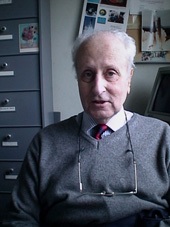 Photo courtesy of Observatoire de Paris
Photo courtesy of Observatoire de Paris
Jean-Louis Steinberg
Contributed by James Lequeux
Jean-Louis Steinberg, who was one of the founders of radio astronomy in France, died in Paris on 21 January 2016 at aged 93. Steinberg also started astronomy from space at the Paris-Meudon Observatory, and he created the European journal Astronomy & Astrophysics.
Jean-Louis was born on 7 June 1922 in Paris. After scientific studies, he obtained in 1943 a Doctor of Engineering degree. In June 1944, he was arrested with his parents and one of his two brothers, and was deported to Auschwitz-Birkenau and finally transferred to Buchenwald. He was the only survivor of the four when the camp was liberated by the US army. This led him to dedicate his life after his retirement to the memory of deportees, conscious of being one of the last direct witnesses. He testified in classrooms and conferences of the horror of the concentration camps.
At his return in France in 1945, he began with Jean-Fran¸ois Denisse to develop radio astronomy in France, helped by the director of the physics laboratory of École Normale Supérieure, Yves Rocard. They founded in 1953 the radio astronomy station of the Paris-Meudon Observatory in Nançay. Jean-Louis played a major part in the construction of the large decimeter radiotelescope, which was officially opened in 1965 by General de Gaulle but became fully operational only in 1967.
At the same time, he founded in 1963 the "Service d'Astronomie Spatiale" (Space astronomy service) in Meudon. Initially, it was devoted to very low-frequency radio astronomy from space: two French Rubis rockets with low-frequency receivers and very long deployed dipole antennas were launched in 1965 and 1967. The Galactic radiation between 1.16 and 2.40 MHz was detected, as well as its absorption along the Galactic plane. The behavior of antennas in the ionospheric plasma, and the ionospheric thermal noise, were studied in detail theoretically, and experimentally by three other rocket flights. Steinberg was also interested in the directivity of solar bursts of Type I and III, which can only be studied by simultaneous observations from distant places. This resulted in the launch on 28 May 1971 of the Stereo-1 experiment on board the Soviet probe Mars-3, a 169-MHz Sun-pointed radiometer working simultaneously with the Nançay radio heliograph and a multichannel spectrograph. The beaming properties of the solar bursts were thus shown for the first time. A similar experiment at lower frequencies was placed on the Soviet probe Mars-7 in 1973. Later, many radio receivers at various frequencies have been put on space vehicles to study the solar and planetary radio emissions, thermal or non-thermal, as well as the radiation from the magnetospheric bow shock: on ISEE 1, 2 and 3, Wind, Ulysses and Cassini. The last scientific paper of Jean-Louis, in 2003, was on the propagation through the magnetosphere and the solar wind of the terrestrial kilometric emissions previously discovered by his staff.
Jean-Louis Steinberg liked writing and was always been interested in scientific publications. We published together in 1960 a small textbook on radio astronomy, Radioastronomie : Les méthodes radioélectriques au service de l'Astrophysique, which was soon translated into Russian, then into English by Ron Bracewell, and which had some success with graduate students. Jean-Louis was offered in 1962 the job of Editor in Chief of the French journal Annales d'Astrophysique, which he ran with his wife Madeleine, who was fluent in English and Russian. In 1968, he went to look for citations of the papers published in this journal in the Science Citation Index, and was horrified to see that the journal was not even mentioned, and probably not read by English-speaking people. He then succeeded, together with Jan Oort, in convincing Netherlands and Germany to merge their astronomy journals into a single European one: this was Astronomy & Astrophysics founded in 1969. Naturally, he was one of the two first Editors in Chief, still helped very efficiently by Madeleine; Stuart Pottash was the other one. Jean-Louis kept the position for five years, making the new journal a great success.
Jean-Louis Steinberg published a detailed account of his life and activities in a paper entitled "The scientific career of a team leader," Planetary and Space Science 49 (2001) 511-522, and took an active part in the writing of the seven papers devoted to the history of French radio astronomy published in the Journal of Astronomical History and Heritage.
Affected by the illness and the death of Madeleine a few years ago, he was then rarely seen at the Observatory. Those who had the chance of knowing him will remember Jean-Louis Steinberg as someone always accessible and attentive to others. He was a man of exceptional moral integrity, and a visionary, bright and charismatic scientist.
![[IAU logo]](iau_wb_thumb.jpg)
![[URSI logo]](URSI-logo-thumb.jpg)
![[Karl Jansky at his antenna]](jansky_photo_02_thumb.jpg)
![[Reber's Wheaton antenna]](Reber_Telescope_Wheaton_thumb.jpg)
![[Dover Heights]](Dover_Heights_02_thumb.jpg)
![[4C telescope]](GB61-195_4C_telescope_thumb.jpg)
![[Ewen and horn antenna]](ewen_horn1s.jpg)
![[Dwingeloo, 1956]](Dwingeloo-1956-thumb.jpg)
![[Jocelyn Bell Burnell and Cambridge antenna used in pulsar discovery]](burnell2_thumb.jpg)
![[Lovell Telescope at Jodrell Bank]](site_1594_0001-500-334-20180316163019-thumb150.jpg)
![[Wilson, Penzias, and Bell Labs horn antenna]](wilson-penzias-horn_thumb.jpg)
![[6-m Millimeter Radio Telescope in Mitaka, Japan]](6m-thumb.jpg)

